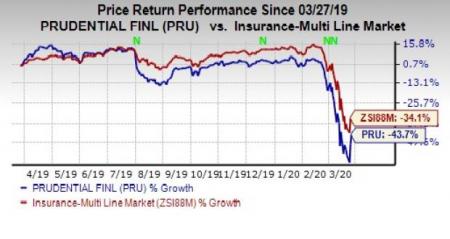
- All Instrument Types
- Indices
- Equities
- ETFs
- Funds
- Commodities
- Currencies
- Crypto
- Bonds
- Certificates
Please try another search

Will Low Interest Rates Create A Headwind For Prudential?

Prudential Financial, Inc. (NYSE:PRU) has been gaining momentum on strong premiums earned from its life insurance business and high net investment income, which, in turn, has been boosting top-line growth.
However, given the coronavirus outbreak, the Federal Reserve in the United States slashed interest rates by 50 basis points on Mar 3. Following the rate cut, the recent announcement of the Fed to lower interest rates to zero-level comes as disappointing news for most life insurance companies in the United States. The rate cut is one of the measures to stimulate the U.S. economy, which has been sluggish due to the COVID-19 pandemic.
Such resortment to zero-interest rates can be traced back to the recession period in 2008.
With the economy being in jeopardy, the Fed also aimed at injecting liquidity into the U.S economy by purchasing Treasurys and mortgage-backed securities worth $700 billion.
Notably, most life insurance companies often suffer when interest rates get lowered. Life insurance companies mostly depend on premiums received from their members, which they invest to get higher returns. Hence, slashed interest rates often make life insurance products unattractive and result in lower receipt of premiums.
The pandemic, which is adversely impacting the U.S. economy, is also expected to dent top-line growth of most life insurance companies in the United States and Prudential (LON:PRU) is no exception.
Net premiums earned and net investment income act as two important drivers of Prudential’s top-line growth. While the company’s net premiums earned have witnessed a CAGR of 4.7% in the past four years (2015-2019), its net investment income has seen a CAGR of 4.4% over the same period. However, the current low interest rate environment is likely to keep investment yields under pressure, which would consequently weigh on its overall investment income.
Prudential’s exposure to products like annuities and universal life, which guarantee minimum return, is also likely to affect it. When interest rates are lowered, it increases the value of the guaranteed liabilities for the company.
Shares of this Zacks Rank #4 (Sell) company have lost 43.7% in a year compared with the industry’s decline of 34.1%.

Nevertheless, we believe that the company’s enhanced suite of retirement and life insurance products is likely to drive its shares going forward. Prudential’s vast distribution network and superior brand image are also expected to give it a competitive edge.
Stocks to Consider
Some better-ranked stocks in the insurance space are AXIS Capital Holdings Limited (NYSE:AXS) , First American Financial Corporation (NYSE:FAF) , and ProAssurance Corporation (NYSE:PRA) . While First American Financial currently sports a Zacks Rank #1 (Strong Buy), AXIS Capital and ProAssurance carry a Zacks Rank #2 (Buy). You can see the complete list of today’s Zacks #1 Rank stocks here.
AXIS Capital, First American Financial and ProAssurance surpassed estimates in the last reported quarters by 150%, 33.33% and 23.03%, respectively.
Just Released: Zacks’ 7 Best Stocks for Today
Experts extracted 7 stocks from the list of 220 Zacks Rank #1 Strong Buys that has beaten the market more than 2X over with a stunning average gain of +24.5% per year.
These 7 were selected because of their superior potential for immediate breakout.
See these time-sensitive tickers now >>
Prudential Financial, Inc. (PRU): Free Stock Analysis Report
Axis Capital Holdings Limited (AXS): Free Stock Analysis Report
ProAssurance Corporation (PRA): Free Stock Analysis Report
First American Financial Corporation (FAF): Free Stock Analysis Report
Original post
Zacks Investment Research
Related Articles

Home Depot’s (NYSE:HD) Q4 2024 report and guidance for 2025 have plenty to be unhappy about, but the simple truth is that this company turned a corner in 2024. It is on track for...

Nvidia is scheduled to release its Q4 earnings report at 4:20PM ET on Wednesday. A call with CEO Jensen Huang is set for 5:00PM ET. The chipmaker’s results will serve as a...

Warren Buffett has always critiqued airline stocks for being overly capital-intensive, exhibiting low growth, and relying heavily on cyclical consumer travel patterns—further...
Are you sure you want to block %USER_NAME%?
By doing so, you and %USER_NAME% will not be able to see any of each other's Investing.com's posts.
%USER_NAME% was successfully added to your Block List
Since you’ve just unblocked this person, you must wait 48 hours before renewing the block.
I feel that this comment is:
Thank You!
Your report has been sent to our moderators for review




Add a Comment
We encourage you to use comments to engage with other users, share your perspective and ask questions of authors and each other. However, in order to maintain the high level of discourse we’ve all come to value and expect, please keep the following criteria in mind:
Enrich the conversation, don’t trash it.
Stay focused and on track. Only post material that’s relevant to the topic being discussed.
Be respectful. Even negative opinions can be framed positively and diplomatically. Avoid profanity, slander or personal attacks directed at an author or another user. Racism, sexism and other forms of discrimination will not be tolerated.
Perpetrators of spam or abuse will be deleted from the site and prohibited from future registration at Investing.com’s discretion.